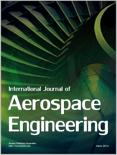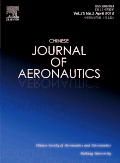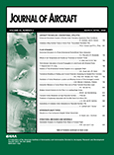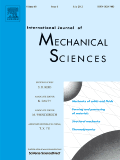
AIRCRAFT ENGINEERING AND AEROSPACE TECHNOLOGY
Scope & Guideline
Bridging theory and practice in aerospace technology.
Introduction
Aims and Scopes
- Aerodynamic Studies and Optimization:
Research on aerodynamic performance, drag reduction, and control strategies for various aircraft configurations, including UAVs and traditional aircraft. - Materials and Manufacturing Innovations:
Exploration of advanced materials, composites, and manufacturing techniques, emphasizing the development of durable and lightweight components for aircraft. - Control Systems and Automation:
Development and analysis of control systems for aircraft and UAVs, including fault-tolerant and adaptive control methodologies. - Environmental Impact and Sustainability:
Investigations into the environmental effects of aviation operations, including emissions analysis, sustainable fuels, and energy efficiency. - Safety and Risk Management:
Research focused on aviation safety, risk assessment methodologies, and the impacts of human factors in aircraft operations. - Computational Methods and Simulations:
Utilization of computational fluid dynamics (CFD), finite element analysis (FEA), and other simulation techniques to model and predict aircraft performance. - Emerging Technologies in Aviation:
Exploration of innovative technologies such as electric propulsion, urban air mobility, and autonomous systems in aviation.
Trending and Emerging
- Sustainable Aviation Practices:
Increased research on sustainable fuels, emissions reduction, and eco-friendly aviation technologies, driven by global environmental concerns. - Autonomous and Unmanned Aerial Vehicles (UAVs):
A growing body of work focuses on the design, control, and applications of UAVs, indicating a trend towards automation in aviation. - Advanced Materials and Structures:
Research on innovative materials, including composites and smart materials, is gaining prominence, particularly in relation to weight reduction and performance enhancement. - Data-Driven and AI Applications:
The integration of artificial intelligence and machine learning techniques in various aspects of aviation, from control systems to predictive maintenance, is an emerging focus. - Urban Air Mobility (UAM):
Exploration of concepts related to urban air mobility, including eVTOL aircraft and their integration into existing transportation systems, reflects a shift towards future urban transport solutions. - Cybersecurity in Aviation Systems:
Research addressing the security of aviation systems against cyber threats is becoming increasingly critical, aligning with global security concerns.
Declining or Waning
- Traditional Propulsion Systems:
Research focusing on conventional jet engines and turbofans has decreased as attention shifts towards sustainable and alternative propulsion systems. - Basic Aerodynamics without Advanced Applications:
Studies that cover basic aerodynamic principles without application to modern technologies or issues are less frequently published, reflecting a trend towards applied research. - Historical Analysis of Aviation Practices:
Papers that primarily focus on historical practices in aviation, without a forward-looking perspective or implications for modern aviation, are becoming less common.
Similar Journals

International Journal of Aerospace Engineering
Exploring New Frontiers in Aerospace TechnologyThe International Journal of Aerospace Engineering, published by HINDAWI LTD, stands at the forefront of innovation and research in the field of aerospace engineering. With an impact factor reflecting its contributions to the discipline and classified in Quartile 3 (Q3) for the year 2023, this journal provides a platform for high-quality, peer-reviewed articles that delve into advancements and challenges in aerospace technology and applications. Since its inception in 2008, the journal has embraced an Open Access model, promoting unrestricted dissemination of research findings to foster collaboration and knowledge sharing among researchers, professionals, and academia. The journal covers a broad spectrum of topics, aiming to enhance understanding and give insight into aerospace engineering's multifaceted aspects. With its coverage in the Scopus database, ranking 71 out of 153 in the aerospace engineering category, the journal is a valuable resource for those engaged in this dynamic field, ensuring that high-impact research receives the visibility it deserves.

Chinese Journal of Aeronautics
Navigating the forefront of aeronautical science.Chinese Journal of Aeronautics, published by Elsevier Science Inc, serves as a premier platform for cutting-edge research in the field of aerospace and mechanical engineering. With an impressive impact factor that reflects its significant contribution to the discipline, this Open Access journal has been disseminated globally since 2002, allowing unrestricted access to high-quality articles and research findings. The journal is recognized for its exceptional ranking, holding a prestigious Q1 category in both Aerospace Engineering (Rank #8/153, 95th percentile) and Mechanical Engineering (Rank #46/672, 93rd percentile) as of 2023. It publishes original research, reviews, and technical notes that enhance our understanding of aeronautics and its applications, making it an essential resource for researchers, professionals, and students alike. Located in New York, USA, the journal continues to foster innovation and collaboration in aeronautical sciences, shaping the future of aviation and space exploration.

JOURNAL OF AIRCRAFT
Unraveling the Science of Flight.JOURNAL OF AIRCRAFT, published by the American Institute of Aeronautics and Astronautics, stands at the forefront of aerospace engineering research, serving as a critical resource for researchers, professionals, and students in the field. With a proud publication history dating back to 1964 and continuing through 2024, the journal has established itself as a leading forum for innovative studies and advancements in aircraft design, technology, and utilization. Notably, it holds a prestigious Q1 ranking in Aerospace Engineering and is positioned at the 75th percentile among its peers. As a non-open access publication, it offers a subscription-based model, ensuring high-quality content disseminated to a discerning audience. The ISSN 0021-8669 and E-ISSN 1533-3868 provide easy reference for those seeking to engage with pioneering research in aviation and aircraft systems. Researchers and practitioners alike will find valuable insights and comprehensive analyses in this esteemed journal that continually shapes the development of the aerospace industry.

Aerospace is a premier open-access journal published by MDPI, established in 2014 and dedicated to the dynamic field of aerospace engineering. With an impressive Q2 ranking in the 2023 category of Aerospace Engineering, this journal is a vital resource for researchers, professionals, and students interested in advancements and innovations in aerodynamics, avionics, propulsion, and more. Operating from Switzerland, Aerospace provides a platform for the dissemination of high-quality research articles and reviews, contributing to the ongoing dialogue in the aerospace community. This journal not only enhances visibility through its open access model but also ensures that critical knowledge is freely available, fostering collaborative efforts and inspiring the next generation of aerospace engineers. With a Scopus ranking of #60 out of 153 in the Aerospace Engineering category, it plays a significant role in shaping the future of aviation and space exploration.

AEROSPACE AMERICA
Charting New Territories in Aerospace ResearchAerospace America, published by the American Institute of Aeronautics and Astronautics, stands as a crucial platform within the field of aerospace engineering. With over 30 years of dedication to advancing aerospace knowledge, the journal provides a comprehensive exploration of topics ranging from cutting-edge aerospace technology to aviation policy and industry developments. While it currently resides in the fourth quartile of the Scopus rankings for aerospace engineering, the journal aims to enhance its visibility and impact among researchers, professionals, and students. Access to its content is traditionally through institutional subscriptions, aligning with its mission to foster informed discussions and innovations in aerospace. As professionals and academics navigate the evolving landscape of aeronautics, Aerospace America remains a pivotal resource for those committed to the future of aerospace exploration and technology.

INTERNATIONAL JOURNAL OF MECHANICAL SCIENCES
Advancing the Frontiers of Mechanical InnovationThe INTERNATIONAL JOURNAL OF MECHANICAL SCIENCES, published by PERGAMON-ELSEVIER SCIENCE LTD, stands as a premier platform for groundbreaking research in the field of engineering and applied sciences. With an impressive convergence of scholarly work from 1960 to 2024, the journal maintains its position in the elite Q1 quartile across several categories, including Aerospace Engineering, Mechanics of Materials, and Ocean Engineering, among others. Its esteemed rank within the Scopus database further underscores its vital role in advancing knowledge in Mechanical Engineering and related disciplines, holding ranks in the top percentiles. While it operates on a subscription basis, the journal prioritizes delivering high-quality, peer-reviewed articles that not only inform but also inspire innovation within academia and industry alike. The INTERNATIONAL JOURNAL OF MECHANICAL SCIENCES is an essential resource for researchers, professionals, and students aiming to deepen their understanding and contribute to the dynamic landscape of mechanical sciences.

Advances in Aircraft and Spacecraft Science
Advancing Technologies that Propel Aviation and SpacecraftAdvances in Aircraft and Spacecraft Science is a distinguished journal published by TECHNO-PRESS, focusing on the rapidly evolving fields of aerospace engineering and fluid dynamics. With an ISSN of 2287-528X and an E-ISSN of 2287-5271, this journal is an invaluable resource for researchers, professionals, and students dedicated to advancing knowledge in aircraft and spacecraft technologies. Established in 2014, the journal is committed to disseminating high-quality research findings and innovative methodologies, ensuring that cutting-edge studies can be accessed globally. Despite its current position in the Q4 category for both aerospace engineering and fluid flow transfer processes, it continues to carve a niche in the academic landscape, with Scopus rankings highlighting its contribution to these fields. Operating from South Korea, Advances in Aircraft and Spacecraft Science aims to inspire collaboration and knowledge-sharing among scholars, fostering advancements that drive the aerospace industry forward.

Journal of the Brazilian Society of Mechanical Sciences and Engineering
Innovative insights for tomorrow's engineering challenges.The Journal of the Brazilian Society of Mechanical Sciences and Engineering, published by Springer Heidelberg, is a pivotal platform dedicated to disseminating cutting-edge research in the realm of mechanical sciences and engineering. With an ISSN of 1678-5878 and an E-ISSN of 1806-3691, this journal showcases innovative findings across various categories, including Aerospace Engineering, Automotive Engineering, and Industrial and Manufacturing Engineering. Notably positioned in the Q2 and Q3 quartiles of its fields as of 2023, the journal highlights the importance of rigorous scientific inquiry, contributing significantly to the understanding and application of engineering principles globally. With a Scopus rank reflecting strong performance in multiple engineering disciplines, this journal serves as an invaluable resource for researchers, professionals, and students seeking to advance their knowledge and explore the frontiers of mechanical sciences. The journal covers a broad range of topics and aims to facilitate collaboration and synergy among experts in the field, enhancing the overall impact of mechanical engineering research.

Journal of Aeronautics Astronautics and Aviation
Navigating the Dynamics of Aerospace InnovationJournal of Aeronautics Astronautics and Aviation, published by the Aeronautical & Astronautical Society Republic of China, is a premier scholarly journal dedicated to advancing knowledge in the dynamic fields of aerospace engineering and space sciences. Operating under the ISSN 1990-7710, this journal plays a pivotal role in disseminating innovative research and practice-oriented studies that address both theoretical and applicative aspects of aeronautics and astronautics. With an impressive history spanning from 2006 to 2024, the journal has established itself as a valuable resource for researchers, professionals, and students alike, featuring contributions that reflect the latest developments and trends within the industry. In the latest rankings, it holds a Q3 classification in Aerospace Engineering and Q4 in Space and Planetary Science, indicating its growing influence despite its niche scope. With an open access model that facilitates widespread readership, the Journal of Aeronautics Astronautics and Aviation strives to foster collaboration and knowledge sharing in these ever-evolving scientific domains.

International Journal of Aviation Aeronautics and Aerospace
Elevating Research in Aviation and Aerospace InnovationInternational Journal of Aviation Aeronautics and Aerospace, published by Embry-Riddle Aeronautical University, serves as a pivotal platform for the dissemination of innovative research in the fields of aerospace engineering, civil and structural engineering, and safety, risk, reliability, and quality. With an ISSN of 2374-6793 and designated as an open access journal since 2014, it enables unhindered global access to its scholarly content, fostering collaboration among researchers, professionals, and students in the aviation sector. The journal's presence spans from 2014 to 2024 and is recognized within the Q3 category across multiple engineering domains according to recent metrics. Despite its emerging status, it holds respectable rankings in Scopus, demonstrating its relevance and contribution to the academic community, particularly in dynamic engineering sectors. It is an essential resource for anyone looking to enhance their understanding of advancements and challenges in aviation and aerospace solutions.